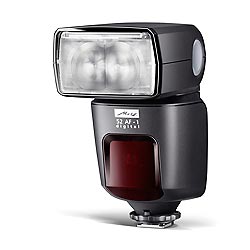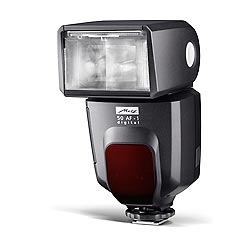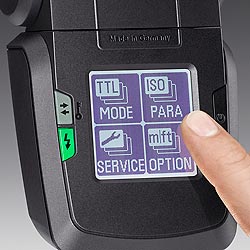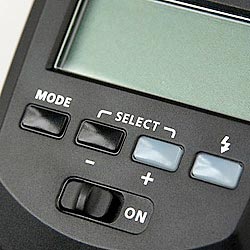Metz Mecablitz 52 AF-1 and Metz Mecablitz 50 AF-1 are the two mid-range flashguns from the world renowned German manufacturer. Although the new Mecablitz 52 AF-1 model is replacing Mecablitz 50 AF-1, both flashes are likely to still be available (new and used) from various sources for years to come. So, many photographers will face a question of whether the newer model is worth spending the extra money. In this review, we'd like to take a closer look at the differences between the two Metz flash units. (Please note that Metz flashes are made in different versions to work with Canon, Nikon, Sony, Olympus/Panasonic/Leica, and Pentax cameras. In this review, we are referring primarily to the Canon models, but most of the points below are valid for all camera systems.)
 |
 |
Clearly, the highlight of the Metz Mecablitz 52 AF-1 flash design is its touchscreen display. Mecablitz 52 AF-1 is the world's first flash that takes advantage of a touch interface. You, however, shouldn't expect this flash to have the usability of multi-touch displays you may have become used to. There are no scroll or pinch gestures, touch-and-holds, or double-taps. The touch functionality is limited to a simple tap, but it still allowed Metz engineers to build a more intuitive user interface.
 |
The menus on Metz Mecablitz 52 AF-1 are easy to read and self-explanatory. Nevertheless, we found some quirks in the menu system that left us wishing for a firmware update already. For example, when in the wireless master mode, the ratios cannot be activated directly from the wireless menu. Instead, you have to go to a completely separate screen and enter the PARA section, select RATIO, and choose the ratio mode. It's not too big of an issue, but we can see how some users may need to refer to the manual to find this function. Generally, however, parameters are easy to find, and to change the value of a given parameter, you simply tap on it on the screen to bring up the list of possible options.
Another new interface feature of Metz 52 AF-1 is the rotating menus. When activated, this function senses the flash orientation and rotates the menus to keep them vertical even when the flash is turned sideways, which is quite useful when you shoot in portrait camera orientation. (This feature was first introduced by Nissin with its Di866 Professional flash.)
Finally, one of the best aspects of the new touch interface is that it can be easily improved or even completely changed with a simple firmware update since it's not dependent on physical buttons.
Now, getting back to the previous model, we found that segment-based display and physical buttons of the older Metz Mecablitz 50 AF-1 do a very good job, as well. Flash parameters are well laid out, but we believe that some of the text on the screen may be too small for an average user. Other than that, we like how Mecablitz 50 AF-1 is operated.
The biggest advantage of the 50 AF-1 interface is the tactile feedback from the buttons. Your fingers "tell" you whether you clicked the button or not. With the touch interface of the 52 AF-1 model, you always need to visually confirm any change. This is the same reason some people prefer to have a QWERTY keyboard on their cellphones rather than a touchscreen.
 |
When it comes to power, it's always the more the better. A more powerful flash gives you more flexibility in use, especially with speedlight modifiers. Metz Mecablitz 52 AF-1 is rated at 52 meters / 170 feet (ISO 100, zoom 105 mm), whereas Mecablitz 50 AF-1 has a Guide Number of 50 meters / 165 feet. It's about 8% power increase, which is probably not a lot but very welcome.
The unbeatable advantage of Metz Mecablitz 52 AF-1 over its predecessor is the Master wireless mode. 52 AF-1 not only can be remotely controlled by other flashes, but it can be a master flash itself. Unlike Nikon Speedlight SB-700, for example, which is also a mid-range flash unit, Mecablitz 52 AF-1 is practically a full-featured master flash. Looking at the Canon version, we can see that it supports all wireless groups, channels, ratios, as well as all TTL and manual modes. (Nikon SB-700 can only work with groups A and B.)
Inability of Metz Mecablitz 50 AF-1 to operate as a wireless master can be a major drawback for photographers looking into using multiple flash setups.
Servo mode allows these Metz flashes to be triggered remotely by a burst of light coming from a flash not designed for the same system. For example, you can trigger a Sony version of the 52 AF-1 flash with a Canon flashgun. You can also add Metz flashes into your studio strobe setup and have them triggered as "dumb" optical slaves.
The advantage of the new Mecablitz 52 AF-1 unit is the Learn function. If for any reason, the 52 AF-1 flash cannot be triggered correctly by a flash, you can "teach" your Metz unit by tapping the Learn button and firing the other flash. We can imagine that you can come across some point-and-shoot cameras, for example, that will not be able to trigger Metz Mecablitz 52 AF-1 properly by default. In such a case, the learning capability will come in handy.
Extended zoom mode was introduced by Metz years ago with Mecablitz 58 AF-1 flash (See our extended zoom test for more details.). The idea behind the extended zoom mode is to set the flash zoom wider than the lens zoom, which allows for some light to be bounced off of the walls to slightly fill in the shadows.
With Mecablitz 52 AF-1, Metz has introduced the "opposite" mode, in which the flash zoom is automatically set one step narrower than the lens. In the spot zoom mode, the flash creates a sort of a spotlight (or vignette) effect, so that the light gradually falls off near the edges of the image. While we never really cared much for the extended zoom mode, we believe that the new spot zoom mode can actually be useful.
While both Metz 52 AF-1 and Metz 50 AF-1 are built very similar in terms of body construction, Mecablitz 52 AF-1 offers a little bit more flexibility when it comes to tilting and rotating the flash head. It adds 30-degree positions to the left and right, as well as a 7-degree down tilt to aid close-up and macro shots.
If a belt pouch is something that you use with your flash, it is worth noting that Metz 52 AF-1 comes with one, whereas Metz 50 AF-1 does not have it. In any case, it is always good to have a pouch for storage and some extra protection.
Aside from the differences already mentioned, Metz Mecablitz 52 AF-1 and 50 AF-1 offer similar sets of other features including rear curtain synchronization, high-speed sync, auto-focus assist, modeling light, etc.
To us, the biggest advantages of Metz 52 AF-1 compared to Metz 50 AF-1 are the wireless master capabilities and the increased maximum light output. The new touch interface, while not perfect, starts a new era of hot shoe flashes, and it is exciting to see a touchscreen on a speedlight. The improved servo mode and flash head along with new spot zoom mode make Metz Mecablitz 52 AF-1 even more attractive. That being said, Metz Mecablitz 50 AF-1 offers an impressive package, as well. So, if you want to save some money and you don't need a wireless master flash, it is still a great choice for a mid-range flashgun.